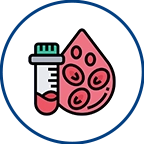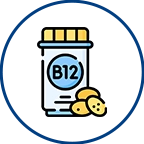Interpreting Eosinophilia High Absolute Eosinophil Count (AEC) and Its Implications

Eosinophilia, characterized by an elevated level of eosinophils in the blood, can indicate various underlying health conditions. The Absolute Eosinophil Count (AEC) is a crucial parameter for measuring eosinophil levels. Accurate diagnosis and effective management of potential health concerns depend on understanding the consequences of a high AEC.
What is Eosinophilia and Absolute Eosinophil Count (AEC)?
Eosinophilia is a condition where the blood contains more eosinophils than average. Eosinophils are a type of white blood cell involved in immune responses, particularly against parasites and allergic reactions. AEC refers to the actual number of eosinophils per microliter of blood.
Home Sample Collection
Causes of Elevated AEC
Allergies and Asthma: Elevated AEC is often associated with allergic reactions and asthma. In these conditions, eosinophils play a role in inflammation and tissue damage.
Parasitic Infections: Eosinophilia can be triggered by certain parasitic infections as the body's defence mechanism against these invaders.
Autoimmune Diseases: Some autoimmune disorders increase eosinophil production, contributing to inflammation.
Drug Reactions: Certain medications can cause eosinophil levels to rise as part of the immune response.
Hypereosinophilic Syndrome: This rare condition involves persistently high eosinophil levels and can lead to organ damage.
Implications and Diagnosis
Clinical Evaluation: A high AEC prompts further investigation. Medical history, symptoms, and physical exams provide insights into the underlying cause.
Additional Tests: To identify the cause, doctors may recommend allergy tests, blood tests for specific diseases, imaging, and sometimes a bone marrow biopsy.
Treatment: Management depends on the underlying cause. Allergies may require antihistamines, while infections might need specific medications.
Limitations and Considerations
Transient Eosinophilia: Elevated AEC might be temporary, caused by infections or allergies. Repeated testing is often necessary to confirm a persistent issue.
Varied Normal Range: Normal eosinophil counts vary among individuals. AEC values should be interpreted alongside symptoms and medical history.
Monitoring: Regular monitoring is essential to assess treatment effectiveness and disease progression, especially in chronic conditions.
Conclusion
A high Absolute Eosinophil Count (AEC) is a valuable indicator of potential health issues. Interpretation requires collaboration between patients and healthcare providers, considering symptoms, medical history, and additional tests. Early diagnosis and management of underlying causes are essential for optimal health outcomes. If you suspect eosinophilia, consult a healthcare professional for accurate evaluation and personalized guidance.
Frequently Asked Questions
What is eosinophilia, and why is the Absolute Eosinophil Count (AEC) important?
Eosinophilia refers to a higher-than-normal level of eosinophils, a type of white blood cell. AEC measures the actual number of eosinophils in the blood per microliter. A high AEC can indicate underlying health issues; understanding its implications is vital.
What are the common causes of elevated AEC?
Elevated AEC can be caused by allergies, asthma, parasitic infections, autoimmune diseases, drug reactions, and hypereosinophilic syndrome. Each of these conditions triggers the body's immune response and leads to increased eosinophil production.
How is eosinophilia diagnosed?
Clinical evaluation, medical history, symptoms, and physical exams provide initial insights. Additional tests such as allergy tests, blood tests for specific diseases, imaging, and sometimes a bone marrow biopsy may be recommended to identify the cause.
What does a high AEC indicate in terms of health implications?
A high AEC suggests an underlying health issue that needs further investigation. The cause could be allergies, infections, autoimmune conditions, or other disorders. For the best possible results in terms of health, accurate diagnosis and care are crucial.
Can a high AEC be a temporary condition?
A high AEC can be brief, often caused by infections or allergies. It's essential to perform repeated tests to confirm whether the elevation is persistent and indicative of an ongoing health issue.
What factors should be considered when interpreting AEC values?
AEC values should be interpreted alongside symptoms, medical history, and clinical context. Average eosinophil counts vary among individuals, so a thorough assessment is necessary.
How is eosinophilia treated?
Treatment depends on the underlying cause. Allergies require antihistamines, infections may need specific medications, and autoimmune conditions can be managed with immune-suppressing drugs.
Q8: Why is monitoring necessary for eosinophilia?
Regular monitoring is crucial, especially for chronic conditions, to track treatment effectiveness, disease progression, and changes in AEC values over time.
Is eosinophilia a severe medical condition?
Eosinophilia is not a condition but an indicator of an underlying issue. The seriousness depends on the cause; some causes are temporary or mild, while others require more intensive management.
When should I consult a healthcare professional regarding eosinophilia?
If you have persistent symptoms, unexplained health issues, or a high AEC, it's advisable to consult a healthcare professional. They can provide accurate evaluation, diagnosis, and guidance for appropriate management.
Book Your Slot
Our Locations Near You in Hyderabad
3KM from Banjara Hills
1.9KM from Yusufguda
3KM from Madhura Nagar
5KM from Shaikpet
Profiles
- Cardiac Risk Profile
- Pituitary marker Profile
- Rheumatoid Arthritis Profile
- Dengue Fever Panel
- Lung Cancer Panel 1 Complete Molecular
- Gastroenteritis Screening Panel
- Thyroid Profile (T3,T4,TSH), Serum
- Pancreatic Marker Profile
- STD profile
- Androgen Profile
- Lipid Profile, Serum
- Pancreatic(acute)Profile
- PCOD Profile
Radiology
Pathology Tests
- Glucose Fasting (FBS),Sodium Fluoride Plasma
- Creatinine, Serum
- Glycosylated Hemoglobin (HbA1C)
- Vitamin B12 (Cyanocobalamin), Serum
- Thyroid Stimulating Hormone (TSH) Ultrasensitive, Serum
- Complete Urine Examination (CUE), Urine
- Liver Function Test (LFT),Serum
- Dengue (IgG & IgM), Serum
- Dengue Antigen (Ns1) Rapid, Serum
- C-Reactive Protein (CRP), Serum
- Widal (Slide Method), Serum
- Total IgE, Serum




